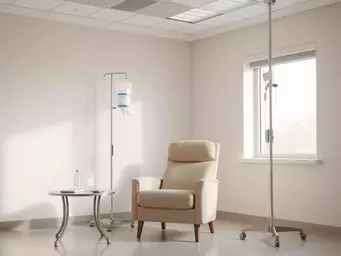Targeted Therapy vs. Traditional Chemotherapy
By Dr. Elise Carter / Nov 21
When embarking on the journey of chemotherapy, understanding its nuances can significantly impact your experience. Consider this: having a clear grasp of what to expect allows you to navigate your treatment with confidence and resilience.
Chemotherapy impacts the body in various ways, primarily by targeting rapidly dividing cells. The visual below highlights key areas affected and common side effects, crucial for understanding and managing the treatment journey.
When navigating a cancer diagnosis, understanding chemotherapy is essential. Chemotherapy is a treatment that uses powerful drugs to destroy cancer cells. It's often prescribed to shrink tumors, prevent cancer from spreading, or eliminate any remaining cancer cells after surgery. Have you ever wondered how chemotherapy works in the body? Let’s explore this critical aspect of cancer treatment.
At Types of Chemotherapy, we believe that knowledge empowers patients. Chemotherapy targets rapidly dividing cells, which are characteristic of cancer. However, it can also affect healthy cells, leading to various side effects. This aspect is crucial to understand as it helps prepare you for what may lie ahead during your treatment journey. For more detailed information on chemotherapy and its impact, you can refer to resources like the National Cancer Institute's guide to chemotherapy.
Chemotherapy involves a combination of drugs that can be administered through various routes, including intravenous or oral. It’s used for several reasons, including:
Understanding the purpose behind chemotherapy can alleviate some of the anxiety associated with treatment. It’s crucial to have open discussions with your healthcare team about why chemotherapy is recommended for your specific situation.
Chemotherapy affects the body in several ways, primarily due to its impact on rapidly dividing cells. While these drugs target cancer cells, they can also affect normal cells. This is why many patients experience side effects. Here are some common areas affected:
Recognizing these effects is vital, as it helps you prepare mentally and physically for what lies ahead. Engaging with your healthcare team about potential impacts can provide clarity and support as you embark on this journey.
Chemotherapy is known for its effectiveness in fighting cancer, but it's equally essential to be aware of the side effects that may arise. Understanding these side effects can empower you to manage them better during your treatment. Here are some of the most common side effects to consider:
Encountering side effects can be distressing, but rest assured you are not alone. As an oncologist, I emphasize the importance of discussing any side effects with your care team. Together, you can develop strategies to manage them and maintain your quality of life throughout treatment. For more comprehensive information on managing these effects, resources like Memorial Sloan Kettering Cancer Center's guide to managing chemotherapy side effects can be very helpful.
Here's a brief recap of the key points discussed so far:
Chemotherapy can be a challenging journey, filled with both physical and emotional hurdles. Understanding the side effects is crucial, but equally important is recognizing the impact of a solid support system. During treatment, reaching out to family, friends, or support groups can make a significant difference in your overall experience. Have you thought about who you can lean on during this time?
Support systems can provide not just emotional comfort, but also practical help. This could include accompanying you to appointments, helping manage daily tasks, or simply being someone to talk to. Ensuring you have a network can ease the burden and make your journey feel a little less daunting. The American Cancer Society offers further insights into chemotherapy side effects and management.
Support systems play a vital role in navigating the complex landscape of chemotherapy. They offer a space for sharing experiences and emotions, which can alleviate feelings of isolation. Consider these benefits of a strong support network:
As you move through treatment, don't hesitate to express your needs to those around you. Remember, it’s okay to ask for help and to lean on those who care about you.
Your healthcare team is your ally in managing chemotherapy side effects. They possess a wealth of knowledge and experience that can guide you through this journey. It’s important to engage with them regularly and voice any concerns you may have. How often do you communicate with your care team?
Here are some steps you can take to optimize your relationship with your healthcare providers:
By actively participating in your care, you empower yourself and can enhance your treatment experience. Remember, your healthcare team is there to support you, so don’t hesitate to reach out!
As you continue on your journey, having access to reliable resources is essential. There are numerous organizations and websites dedicated to providing information about chemotherapy and support for both patients and caregivers. Consider exploring:
These resources can offer not just knowledge but also connections to others who understand what you’re going through. Engaging with these communities can foster a sense of belonging and empowerment.
One of the best things you can do is create a personalized plan to manage your side effects. This might include lifestyle changes, symptom management strategies, and regular check-ins with your healthcare team. Here’s how to get started:
As you create this plan, remember that it’s a living document. You may need to adjust it as your treatment progresses and your needs change.
After completing chemotherapy, ongoing care is critical. Regular follow-ups with your oncologist ensure that any lingering side effects are managed and that your health is being monitored. Have you scheduled your follow-up visits?
In your follow-up care, focus on:
By prioritizing follow-up care, you take an active role in your health and well-being, moving forward with confidence into the next chapter of your life. Always remember, you’re not alone on this journey!
Here is a quick recap of the important points discussed in the article:

 Targeted Therapy vs. Traditional Chemotherapy
Have you considered how understanding cancer treatments can empower your journey? Knowledge not only
Targeted Therapy vs. Traditional Chemotherapy
Have you considered how understanding cancer treatments can empower your journey? Knowledge not only
 Nutrition Strategies for Chemotherapy Patients
Nutrition plays a critical role in supporting your body during chemotherapy. By making informed diet
Nutrition Strategies for Chemotherapy Patients
Nutrition plays a critical role in supporting your body during chemotherapy. By making informed diet
 Preparing for Your First Chemotherapy
Have you ever felt overwhelmed at the thought of a major medical treatment? The uncertainty and anxi
Preparing for Your First Chemotherapy
Have you ever felt overwhelmed at the thought of a major medical treatment? The uncertainty and anxi